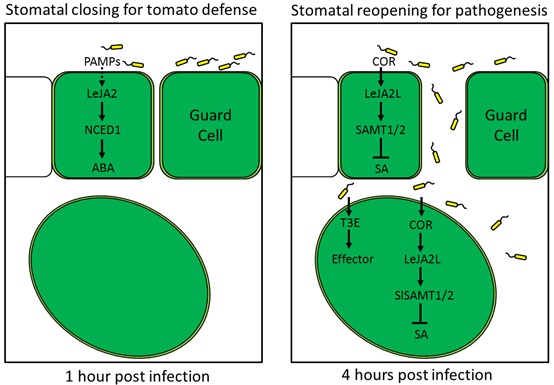
Closely-Related NAC Transcription Factors of Tomato Differentially Regulate Stomatal Closure and Re-opening during Pathogen Attack
Jul 11, 2014 Email"> PrintText Size

Stomata are microscopic pores formed by pairs of guard cells in the epidermis of plants. Plants actively regulate stomatal aperture in response to abiotic environmental conditions to optimize gas exchange and water loss. Stomatal openings are also a major route of pathogen entry into the plant. To restrict pathogen entry, plants close stomata as an integral part of innate immunity. To counteract this defense, Pseudomonas syringae pv. tomato (Pst) produces coronatine (COR), which mimics jasmonic acid (JA), to reopen stomata for bacterial entry. It is believed that abscisic acid (ABA) plays a central role in regulating bacteria-triggered stomatal closure and that stomatal reopening requires the JA/COR pathway, but the downstream signaling events remain unclear.Scientists in Dr. LI Chuanyou’s group from the Institute of Genetics and Development Biology, Chinese Academy of Sciences (IGDB), studied the stomatal immunity of tomato (Solanum lycopersicum ) and report the distinct roles of two homologous NAC transcription factors of tomato, LeJA2 and LeJA2L, in regulating pathogen-triggered stomatal movement. Although LeJA2 and LeJA2L share 66% identity at the amino acid level, they have functionally diverged. The expression of LeJA2 is activated by ABA and genetic manipulation of this gene reveals a positive role of LeJA2 in ABA-mediated stomatal closure.They provide evidence that shows that LeJA2 exerts this effect by regulating the expression of the key ABA biosynthetic gene LeNCED1. In contrast, the expression of LeJA2L is induced by JA and COR, genetic manipulation of this gene shows a positive role of LeJA2L in JA/COR-mediated stomatal reopening. They show that LeJA2L executes this effect by regulating the expression of genes involved in the metabolism of salicylic acid. These results shed new light on the molecular mechanisms of host immunity, pathogen virulence and plant-pathogen co-evolution.This work has been published in The Plant Cell (DOI:10.1105/tpc.114.128272). This research was supported by grants from the Strategic Priority Research Program of the Chinese Academy of Sciences, the Ministry of Science and Technology of China and the National Natural Science Foundation of China.CONTACT:
LI Chuanyou, Group Leader
Institute of Genetics and Developmental Biology, Chinese Academy of Sciences, Beijing, China.
E-mail: cyli@genetics.ac.cn A model for the distinct actions of LeJA2 and LeJA2L in regulating pathogen-triggered stomatal closure and re-opening of tomato. (Image by IGDB)
A model for the distinct actions of LeJA2 and LeJA2L in regulating pathogen-triggered stomatal closure and re-opening of tomato. (Image by IGDB)
Stomata are microscopic pores formed by pairs of guard cells in the epidermis of plants. Plants actively regulate stomatal aperture in response to abiotic environmental conditions to optimize gas exchange and water loss. Stomatal openings are also a major route of pathogen entry into the plant. To restrict pathogen entry, plants close stomata as an integral part of innate immunity. To counteract this defense, Pseudomonas syringae pv. tomato (Pst) produces coronatine (COR), which mimics jasmonic acid (JA), to reopen stomata for bacterial entry. It is believed that abscisic acid (ABA) plays a central role in regulating bacteria-triggered stomatal closure and that stomatal reopening requires the JA/COR pathway, but the downstream signaling events remain unclear.
Scientists in Dr. LI Chuanyou’s group from the Institute of Genetics and Development Biology, Chinese Academy of Sciences (IGDB), studied the stomatal immunity of tomato (Solanum lycopersicum ) and report the distinct roles of two homologous NAC transcription factors of tomato, LeJA2 and LeJA2L, in regulating pathogen-triggered stomatal movement. Although LeJA2 and LeJA2L share 66% identity at the amino acid level, they have functionally diverged. The expression of LeJA2 is activated by ABA and genetic manipulation of this gene reveals a positive role of LeJA2 in ABA-mediated stomatal closure.
They provide evidence that shows that LeJA2 exerts this effect by regulating the expression of the key ABA biosynthetic gene LeNCED1. In contrast, the expression of LeJA2L is induced by JA and COR, genetic manipulation of this gene shows a positive role of LeJA2L in JA/COR-mediated stomatal reopening. They show that LeJA2L executes this effect by regulating the expression of genes involved in the metabolism of salicylic acid. These results shed new light on the molecular mechanisms of host immunity, pathogen virulence and plant-pathogen co-evolution.
This work has been published in The Plant Cell (DOI:10.1105/tpc.114.128272). This research was supported by grants from the Strategic Priority Research Program of the Chinese Academy of Sciences, the Ministry of Science and Technology of China and the National Natural Science Foundation of China.
CONTACT:
LI Chuanyou, Group Leader
Institute of Genetics and Developmental Biology, Chinese Academy of Sciences, Beijing, China.
E-mail: cyli@genetics.ac.cn
LI Chuanyou, Group Leader
Institute of Genetics and Developmental Biology, Chinese Academy of Sciences, Beijing, China.
E-mail: cyli@genetics.ac.cn

A model for the distinct actions of LeJA2 and LeJA2L in regulating pathogen-triggered stomatal closure and re-opening of tomato. (Image by IGDB)
CAS Institutes
There are 124 Institutions directly under the CAS by the end of 2012, with 104 research institutes, five universities & supporting organizations, 12 management organizations that consist of the headquarters and branches, and three other units. Moreover, there are 25 legal entities affiliated and 22 CAS invested holding enterprisesThere are 124 I...>> more
Contact Us

Chinese Academy of Sciences
Add: 52 Sanlihe Rd., Xicheng District, Beijing, China
Postcode: 100864
Tel: 86-10-68597592 (day) 86-10-68597289 (night)
Fax: 86-10-68511095 (day) 86-10-68512458 (night)
E-mail: cas_en@cas.cn

